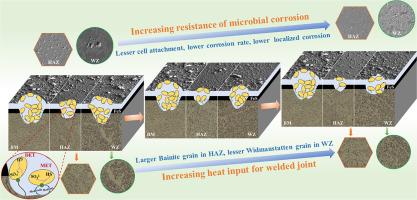Beneficial effect of heat input to improve microbial corrosion resistance of welded joint in X80 steel pipeline
IF 14.3
1区 材料科学
Q1 MATERIALS SCIENCE, MULTIDISCIPLINARY
引用次数: 0
Abstract
In this paper, Desulfovibrio vulgaris corrosion of X80 steel welded joint with different heat inputs was carefully investigated. The results confirmed that in the sterile medium, general corrosion rate and localized corrosion susceptibility of heat affected zone (HAZ) were higher than those of weld zone (WZ) and base metal (BM). In the inoculated medium, the general corrosion rate of HAZ was still higher than that of WZ and BM. However, the number and depth of corrosion pits on WZ and BM surfaces, as well as the localized corrosion susceptibility, were much higher than those in HAZ, which was opposite to that in sterile environment, suggesting that the Desulfovibrio vulgaris corrosion of the welded joint was selective. With heat input increasing from 0.57 kJ/mm to 1.29 kJ/mm, general corrosion rate and localized corrosion susceptibility of HAZ and WZ simultaneously decreased in sterile or inoculated medium. In inoculated medium, localized corrosion of HAZ decreased more sharply than weld zone. Within the range of heat inputs tested, the study discerned a positive correlation: higher heat inputs correlated with an enhanced corrosion resistance of welded joint, irrespective of environmental conditions being sterile or inoculated. The findings provide a solid basis for the welding parameter determination to steel pipelines in oil and gas transportation.

输入热量对提高 X80 钢管焊接接头抗微生物腐蚀性的有利影响
本文仔细研究了不同热输入条件下 X80 钢焊接接头的脱硫弧菌腐蚀情况。结果表明,在无菌培养基中,热影响区(HAZ)的总体腐蚀速率和局部腐蚀敏感性均高于焊接区(WZ)和母材(BM)。在接种培养基中,热影响区的总体腐蚀速率仍高于焊接区和母材。然而,WZ 和 BM 表面腐蚀坑的数量和深度以及局部腐蚀敏感性都远高于 HAZ,这与无菌环境中的情况相反,表明脱硫弧菌对焊接接头的腐蚀具有选择性。随着热输入从 0.57 kJ/mm 增加到 1.29 kJ/mm,在无菌或接种培养基中,HAZ 和 WZ 的总体腐蚀速率和局部腐蚀敏感性同时下降。在接种培养基中,HAZ 的局部腐蚀比焊接区的腐蚀更剧烈。在测试的热输入范围内,研究发现了一种正相关关系:无论环境条件是无菌还是接种,热输入越高,焊接接头的耐腐蚀性越强。研究结果为确定油气运输钢制管道的焊接参数提供了坚实的基础。
本文章由计算机程序翻译,如有差异,请以英文原文为准。
求助全文
约1分钟内获得全文
求助全文
来源期刊

Journal of Materials Science & Technology
工程技术-材料科学:综合
CiteScore
20.00
自引率
11.00%
发文量
995
审稿时长
13 days
期刊介绍:
Journal of Materials Science & Technology strives to promote global collaboration in the field of materials science and technology. It primarily publishes original research papers, invited review articles, letters, research notes, and summaries of scientific achievements. The journal covers a wide range of materials science and technology topics, including metallic materials, inorganic nonmetallic materials, and composite materials.
 求助内容:
求助内容: 应助结果提醒方式:
应助结果提醒方式:


